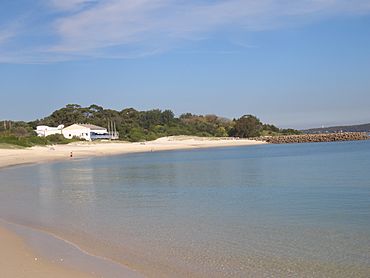Phillip Bay, New South Wales facts for kids
Quick facts for kids Phillip BaySydney, New South Wales |
|||||||||||||||
|---|---|---|---|---|---|---|---|---|---|---|---|---|---|---|---|

Yarra Bay at Phillip Bay
|
|||||||||||||||
| Population | 704 (2016 census) | ||||||||||||||
| Postcode(s) | 2036 | ||||||||||||||
| Elevation | 15 m (49 ft) | ||||||||||||||
| Location | 13 km (8 mi) south-east of Sydney CBD | ||||||||||||||
| LGA(s) | City of Randwick | ||||||||||||||
| State electorate(s) | Maroubra | ||||||||||||||
| Federal Division(s) | Kingsford Smith | ||||||||||||||
|
|||||||||||||||
Phillip Bay is a suburb located in the Eastern Suburbs of Sydney, New South Wales, Australia. It is about 13 kilometres south-east of the main city centre, known as the Sydney central business district. This area is part of the City of Randwick local government area, and its postcode is 2036.
Contents
About Phillip Bay
Phillip Bay is one of the smaller suburbs in the Randwick area. Even though it includes popular spots like Yarra Bay and Bicentennial Park, it doesn't have a lot of buildings packed closely together. It's mostly a residential area, meaning it's where people live. You can find many different types of homes here, like villas, cottages, apartment blocks (up to three floors), and townhouses.
Most of the homes in Phillip Bay are detached houses, meaning they stand on their own. About 80% of homes here are detached, which is much higher than the average for the whole Randwick area (only 28%). There are fewer semi-detached homes, which are houses joined to another house on one side.
You'll find different churches in Phillip Bay, including Catholic and Baptist churches on Yarra Road. There was also an Aboriginal Evangelical Church on Adina Avenue, but it wasn't being used in 2009. La Perouse Primary School, a local school, is also located on Yarra Road. Along Yarra Bay, there are beaches and places for fun activities. Yarra Bay House is a special building located on Yarra Point, between Frenchmans Bay and Yarra Bay.
History of Phillip Bay
First People: Aboriginal History
Aboriginal people were the very first inhabitants of Phillip Bay and the nearby area of La Perouse. Their presence was noted by two important explorers who arrived in January 1788, just six days apart. These were Arthur Phillip from England and Lapérouse from France.
In 1883, a camp for Aboriginal people was set up at Phillip Bay. This camp was managed by a group called the Aborigines Protection Board, which looked after Aboriginal communities. Over the years, different church and welfare groups also helped run the settlement. Because the sand was unstable, the reserve was moved to the Elaroo Avenue area in the late 1920s. Today, Aboriginal people own this land, as well as Yarra Bay House and the land between Frenchmans Bay and Yarra Bay.
European Arrivals
The first European ship, HMS Supply, arrived in Botany Bay on January 18, 1788. On board was Captain Arthur Phillip. He named the anchorage "Phillip Bay." After looking around, Phillip decided the area wasn't suitable for a new settlement.
A few days later, on January 20, Captain John Hunter arrived in his ship, HMS Sirius. Phillip, Hunter, and two other men then explored the coast northwards by boat. They eventually found Port Jackson, which is where Sydney Cove is located. The entire fleet then moved there to establish the new colony.
The nearby suburb of La Perouse was named after the French explorer Jean-François de Galaup, comte de La Pérouse. He arrived at Botany Bay on January 26, 1788, just as the First Fleet was leaving for Port Jackson. The area originally called "Phillip Bay" was later renamed "Yarra Bay," using its Aboriginal name. However, the suburb itself kept the original European name, Phillip Bay.
Like many seaside areas, the region around La Perouse grew popular for outdoor fun and weekend trips. This happened especially after the tram line was built around 1900. During the Great Depression of the 1920s and 1930s, a time when many people lost their jobs and homes, many unemployed people built simple, temporary homes in the Phillip Bay area. Areas like "Happy Valley" and "Hill 60" were to the north and mostly housed white people. Aboriginal people mainly lived in the "Frog Hollow" area to the south.
Yarra Bay House
Yarra Bay House was built in 1903. It was an extra building for the Cable Station at La Perouse, which was used for sending messages across the ocean. When a second cable was laid in 1890, more space was needed for the workers.
After 1917, the Cable Station was no longer needed because new technology made it obsolete. Yarra Bay House then became home to different government groups, including the Education Department. In 1985, the ownership of the house was given to the Aboriginal Land Council. A special freshwater pond, called a billabong, has been created behind Yarra Bay House. This helps bring back local frogs and birds. In 2009, the building was being repaired and restored.
Population Information
According to the 2016 Census, there were 704 people living in Phillip Bay. Most people, about 70.7%, were born in Australia. Also, 75.7% of people spoke only English at home. When it came to religion, the most common choices in Phillip Bay were Catholic (37.3%), No Religion (21.0%), and Anglican (15.4%).
Local Landmarks
- Yarra Bay House
- Yarra Bay Sailing Club
- Yarra Bay
- Yarra Point
- Bumborah Point
- Bicentennial Park
Gallery









